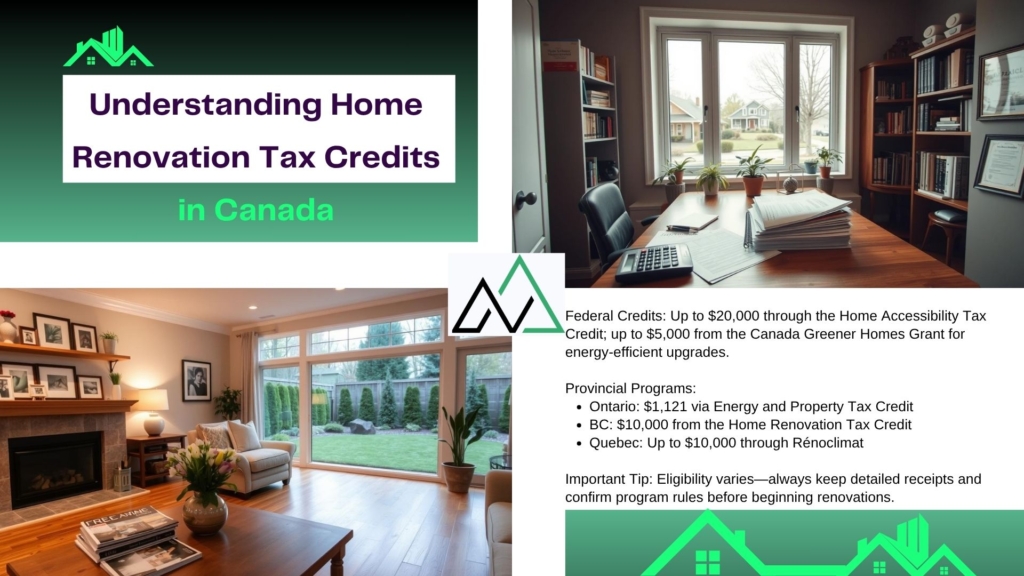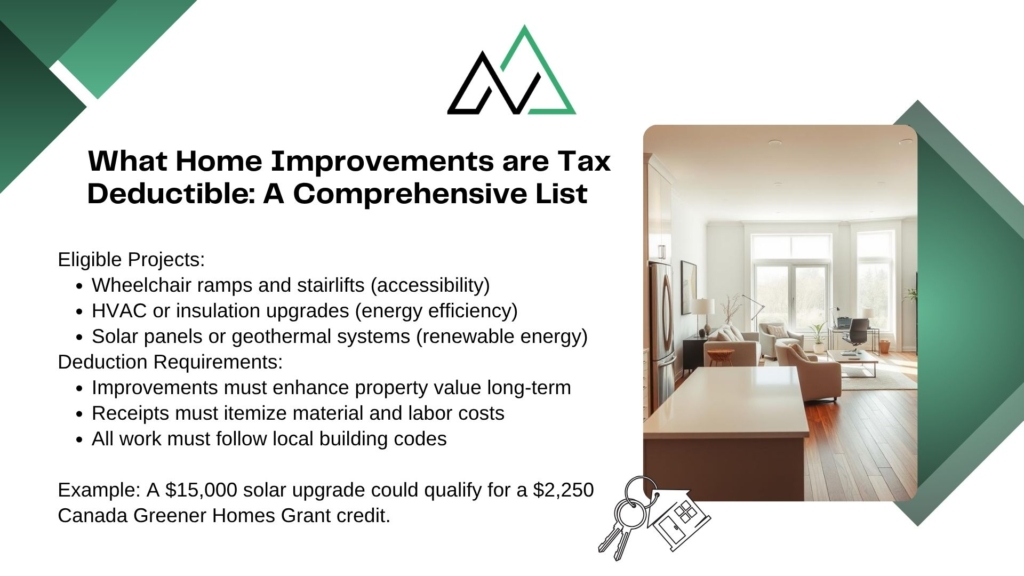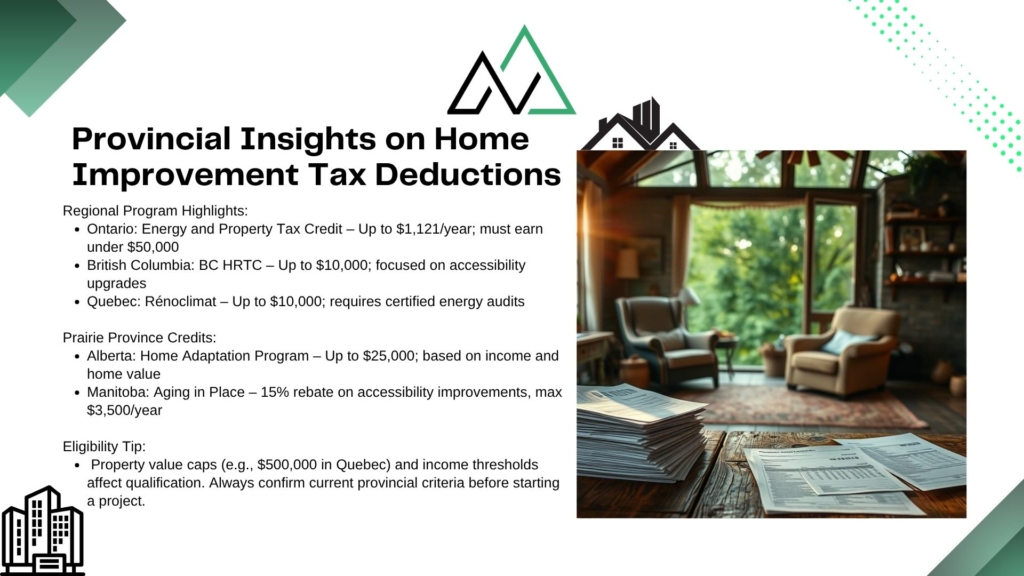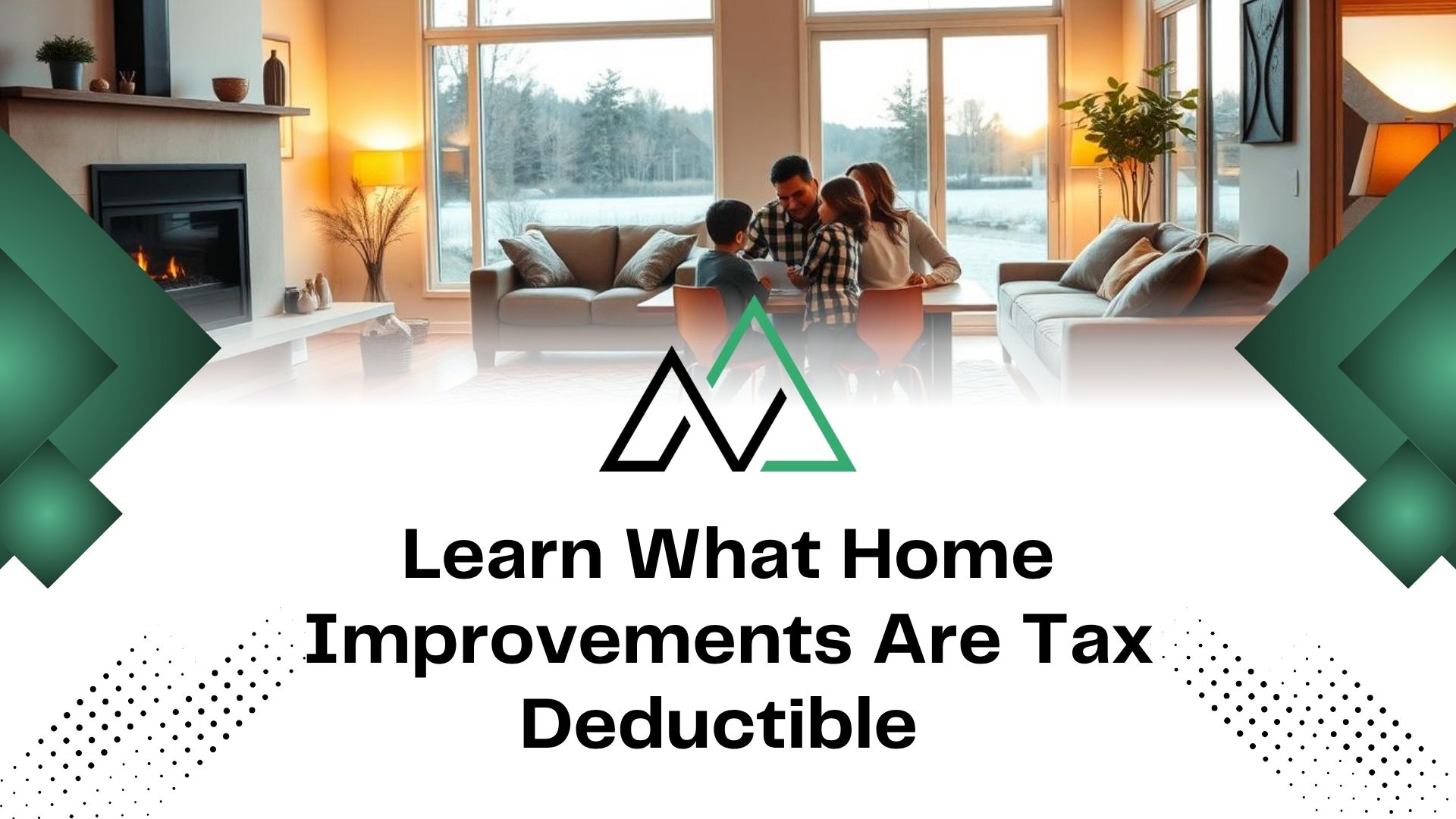Smart property owners know renovations aren’t just about aesthetics—they can also unlock financial advantages. In Canada, certain upgrades may qualify for tax credits, reducing annual obligations while increasing your property’s value. This guide clarifies how to align projects with tax-saving opportunities.
Tax credits for eligible renovations help offset costs for energy-efficient systems, accessibility modifications, or eco-friendly installations. These incentives reward homeowners who invest in upgrades benefiting both their households and communities. With careful planning, you can turn renovation expenses into long-term savings.
New Homes Alberta specializes in guiding buyers and investors through these opportunities. Whether you’re upgrading your first property or expanding a portfolio, understanding deductible expenses ensures smarter financial decisions. Call (403) 305-9167 to discuss personalized strategies.
This article breaks down key concepts for Canadian residents, from defining qualifying projects to navigating paperwork. Discover how strategic upgrades can enhance living spaces while optimizing tax outcomes.
Key Takeaways
- Certain renovations may qualify for federal or provincial tax credits in Canada.
- Energy-efficient and accessibility upgrades often have higher eligibility rates.
- Professional guidance ensures compliance with evolving tax regulations.
- First-time buyers and investors benefit differently from renovation deductions.
- Documentation is critical when claiming expenses during tax filing.
- Combining multiple eligible projects maximizes annual savings potential.
Understanding Home Renovation Tax Credits in Canada
Renovating your property can do more than boost curb appeal—it might also lower your annual tax burden. Canada’s tax credit systems operate at federal and provincial levels, each offering unique benefits for eligible upgrades. Knowing how these programs work helps maximize savings while complying with regulations.

Federal Tax Credit Options
The federal government provides nationwide incentives like the Home Accessibility Tax Credit, covering up to $20,000 annually for modifications aiding seniors or disabled residents. Energy-efficient retrofits may qualify for the Canada Greener Homes Grant, offering up to $5,000 for insulation or solar panel installations.
Provincial Tax Credit Overview
Provinces supplement federal programs with localized incentives. For example:
| Province | Program | Maximum Credit |
|---|---|---|
| Ontario | Ontario Energy and Property Tax Credit | $1,121 |
| British Columbia | BC Home Renovation Tax Credit | $10,000 |
| Quebec | Rénoclimat Program | $10,000 |
Eligibility often depends on project scope and documentation. Always verify requirements with local authorities or tax professionals before starting renovations.
What Home Improvements are Tax Deductible: A Comprehensive List
Certain property enhancements go beyond boosting functionality—they open doors to government incentives. Projects aligning with national priorities like energy conservation or accessibility often qualify for financial relief through tax credits.

Common Eligible Projects
Key upgrades meeting federal or provincial criteria include:
- Installing wheelchair ramps or stairlifts for accessibility
- Upgrading insulation or HVAC systems for energy efficiency
- Adding solar panels or geothermal heating systems
Validation Requirements
To claim expenses, projects must meet three criteria:
- Improvements must permanently enhance the property
- Receipts must detail material and labor costs
- Work must comply with local building codes
Example: A $15,000 solar panel installation might yield a $2,250 credit under the Canada Greener Homes Grant. “Always retain contractor invoices and certification documents,” advises a CRA representative. Proper records simplify tax filing and audit processes.
For rental properties, only upgrades benefiting tenants—like safety features—qualify. Personal aesthetic choices, such as luxury flooring, typically don’t meet eligibility thresholds. Consult provincial guidelines to confirm which expenses apply to your residence.
Provincial Insights on Home Improvement Tax Deductions
Each Canadian province crafts distinct pathways for turning home upgrades into financial relief. Regional programs vary significantly in eligibility rules and credit calculations, often influenced by factors like property value and household income.

Regional Program Comparisons
Ontario, British Columbia, and Quebec demonstrate how localized priorities shape tax incentives:
| Province | Program | Max Credit | Key Requirement |
|---|---|---|---|
| Ontario | Energy and Property Tax Credit | $1,121/year | Income under $50,000 |
| British Columbia | BC HRTC | $10,000 | Accessibility focus |
| Quebec | Rénoclimat | $10,000 | Energy audits required |
Prairie Province Particulars
Alberta and Manitoba apply unique criteria for renovation credits:
- Alberta’s Home Adaptation Program offers up to $25,000 for disability modifications, considering both property value and family income
- Manitoba’s Aging in Place initiative provides 15% rebates on accessibility upgrades, capped at $3,500 annually
“Credits in Western provinces often prioritize multi-year projects that enhance long-term livability,” notes Alberta’s housing guidelines.
Home value thresholds impact eligibility in several regions. For instance, Quebec limits credits to properties assessed below $500,000. Always verify income ceilings and documentation rules before applying—these change frequently and affect your potential savings.
Maximizing Your Tax Savings with Renovation Expenses
Strategic home upgrades become financial tools when paired with proper tax planning. To unlock maximum savings, meticulous documentation and awareness of program requirements are essential. These practices ensure every dollar spent works harder for your household.

Effective Record Keeping for Deductions
Organize receipts for all renovation costs—even minor items like grab bars or threshold ramps. Digital tools simplify tracking:
- Scan invoices immediately after payments
- Label files by project type and date
- Store backups in cloud storage
Avoid common mistakes like mixing personal and renovation expenses. Create separate accounts for project funds. Contractors must provide detailed breakdowns of labor and materials to meet qualifying standards.
Strategies for Claiming Maximum Credits
Time projects to align with fiscal years. Combine federal and provincial programs where allowed. For example:
- Complete energy audits before starting efficiency upgrades
- Split multi-phase projects across tax years
- Verify eligibility before purchasing materials
“Homeowners often overlook small upgrades that collectively boost credits. Document every qualifying improvement, no matter the size.” — Tax Advisory Specialist
Review income tax thresholds annually. Some provinces reduce credits as earnings increase. Consult professionals when renovating rental properties—different rules apply to investment-related costs.
Green Home Renovation Incentives
Eco-conscious upgrades offer dual benefits: reducing environmental impact and accessing financial incentives. Federal and provincial programs reward property owners who prioritize energy efficiency and sustainable housing solutions. Let’s explore how these initiatives can offset renovation costs while benefiting your household and community.

Canada Greener Homes Loan and Grants
The Canada Greener Homes Loan provides interest-free financing up to $40,000 for energy-efficient retrofits. This program complements existing grants like the Canada Greener Homes Grant, which offers up to $5,000 for qualifying upgrades. Eligible projects include:
- High-efficiency heating systems (furnaces, heat pumps)
- Energy-rated doors and windows
- Smart thermostats and water-saving fixtures
| Program | Funding Type | Max Amount |
|---|---|---|
| Federal Loan | Interest-Free Financing | $40,000 |
| Alberta Rebate | Instant Discounts | $3,500 |
| BC Hydro | Cash Back | $3,000 |
Energy Efficiency Upgrades and Rebates
Provincial rebates vary but typically require pre-approval and professional installation. For example, replacing old doors with ENERGY STAR® models could yield $50-$150 per installation. Heating system upgrades often provide the highest returns—a new geothermal system might qualify for $3,000+ in combined incentives.
Application processes usually involve three steps:
- Complete a pre-retrofit energy assessment
- Submit quotes from licensed contractors
- Provide post-installation verification
“Modern fixtures and efficient systems cut utility bills by 20-30% annually while increasing property value.” — Energy Advisor
Navigating Renovation Expenses for Residential Properties
Balancing renovation budgets requires both financial savvy and awareness of tax opportunities. Property owners can maximize returns by understanding expense tracking protocols and program eligibility differences between primary residences and income-generating properties.

Mastering Financial Documentation
Organized record-keeping transforms renovation costs into potential savings. Consider these methods:
- Use mobile apps to scan receipts immediately after purchases
- Create separate folders for contractor invoices and material costs
- Note installation dates beside each expense record
One Alberta investor reduced audit risks by color-coding files for accessibility upgrades like grab bars and ramps. “Tracking every receipt transforms renovation costs into strategic investments,” notes a Calgary tax advisor.
Property Type Tax Considerations
Rental properties and primary residences follow different deduction rules:
| Upgrade Type | Primary Residence | Rental Property |
|---|---|---|
| Accessibility Features | Immediate tax credits | Depreciation over time |
| Energy Retrofits | Combined federal/provincial credits | Capital cost allowance |
Seniors and persons with disabilities often qualify for enhanced credits. The Home Accessibility Tax Credit specifically helps those over 65 or with mobility challenges, covering items like shower seats and security bars.
Smart planners grab available credits by timing projects across fiscal years. A Vancouver couple secured $8,500 in returns by splitting their kitchen accessibility remodel between two tax periods.
Expert Guidance from New Homes Alberta
Navigating tax incentives for renovations requires up-to-date knowledge and strategic planning. New Homes Alberta’s specialists decode complex regulations into actionable steps, helping homeowners align projects with available rebates. Their expertise spans federal programs like the new housing rebate to provincial initiatives supporting persons disabilities.

Professional Tips and Industry Insights
Experts recommend these strategies to maximize savings:
- Prioritize equipment upgrades that qualify for multiple credits, like wheelchair lifts or energy-efficient HVAC systems
- Monitor annual changes to the accessibility tax credit thresholds for aging-in-place modifications
- Combine provincial rebates with federal grants where permitted
Recent updates to Alberta’s new housing rebate now cover 15% of eligible expenses for secondary suites. “Installing certified equipment ensures compliance while boosting credit eligibility,” notes a New Homes Alberta advisor.
Contact Information and Resources
Property owners supporting persons disabilities often qualify for enhanced home accessibility tax benefits. New Homes Alberta provides:
- Customized renovation checklists matching your tax profile
- Pre-approval assistance for provincial/federal applications
- Contractor referrals for code-compliant installations
Call (403) 305-9167 to discuss how adaptive equipment or energy retrofits could reduce your renovation costs. Their team stays current on evolving programs, ensuring clients never miss savings opportunities tailored to their needs.
Conclusion
Strategic renovations create lasting value beyond immediate upgrades. By leveraging federal and provincial tax credits, Canadian property owners reduce annual obligations while enhancing their living spaces. Programs like the Canada Greener Homes Grant and regional incentives reward investments in energy-efficient systems or accessibility features.
Effective documentation systems transform renovation costs into financial advantages. Homeowners and small business investors benefit from tracking expenses across multiple years—organized records simplify claiming deductions while minimizing audit risks. Over time, these upgrades boost property value and reduce long-term tax burdens.
New Homes Alberta helps navigate evolving regulations to maximize returns. Whether upgrading a primary residence or rental unit, expert guidance ensures compliance with program requirements. Their team identifies credits matching your renovation goals while avoiding common filing errors.
Ready to turn improvements into savings? Call (403) 305-9167 for personalized strategies aligning your projects with current tax opportunities. Smart planning today yields benefits for years to come.
FAQ
Which federal tax credits apply to home renovations?
The Multigenerational Home Renovation Tax Credit and Home Accessibility Tax Credit are key federal programs. These cover up to $20,000 in eligible expenses for accessibility upgrades or creating secondary suites for seniors/persons with disabilities.
Do bathroom renovations qualify for tax deductions?
Bathroom modifications like walk-in tubs, grab bars, or widened doorways may qualify under accessibility-focused credits. Cosmetic upgrades typically don’t qualify unless part of approved energy efficiency or safety programs.
How do provincial tax credits differ across Canada?
Alberta offers a 25% rebate on solar installations through the Residential and Commercial Solar Program. Ontario provides the Ontario Energy and Property Tax Credit, while BC’s PST Rebate applies to energy-efficient heating systems. Requirements vary by region.
Can landlords claim tax credits for rental property upgrades?
Yes – improvements to rental units like energy-efficient windows or accessibility features may qualify as capital expenses. These costs get deducted through Capital Cost Allowance (CCA) over several years rather than single-year credits.
What documentation is required for renovation tax claims?
A> Keep dated receipts, contractor invoices, before/after photos, and product specification sheets. For energy rebates, retain copies of ENERGY STAR certifications and provincial program approval letters.
Are heat pumps covered under green renovation incentives?
A> Air-source and ground-source heat pumps qualify for the Canada Greener Homes Grant, offering up to $6,500 in rebates. Some provinces like Nova Scotia add stacked incentives reaching $30,000 for full electrification projects.
What’s the maximum claimable amount for accessibility modifications?
A> The Home Accessibility Tax Credit allows annual claims up to $20,000, providing a maximum $3,000 tax reduction. Seniors and persons with disabilities can combine this with provincial programs like Alberta’s Assistive Devices Benefit.
How long do I have to claim renovation tax credits?
A> Most federal credits must be claimed within one year of renovation completion. Provincial programs like Quebec’s RénoVert allowed retroactive claims up to two years, but always verify current deadlines with CRA or local authorities.

